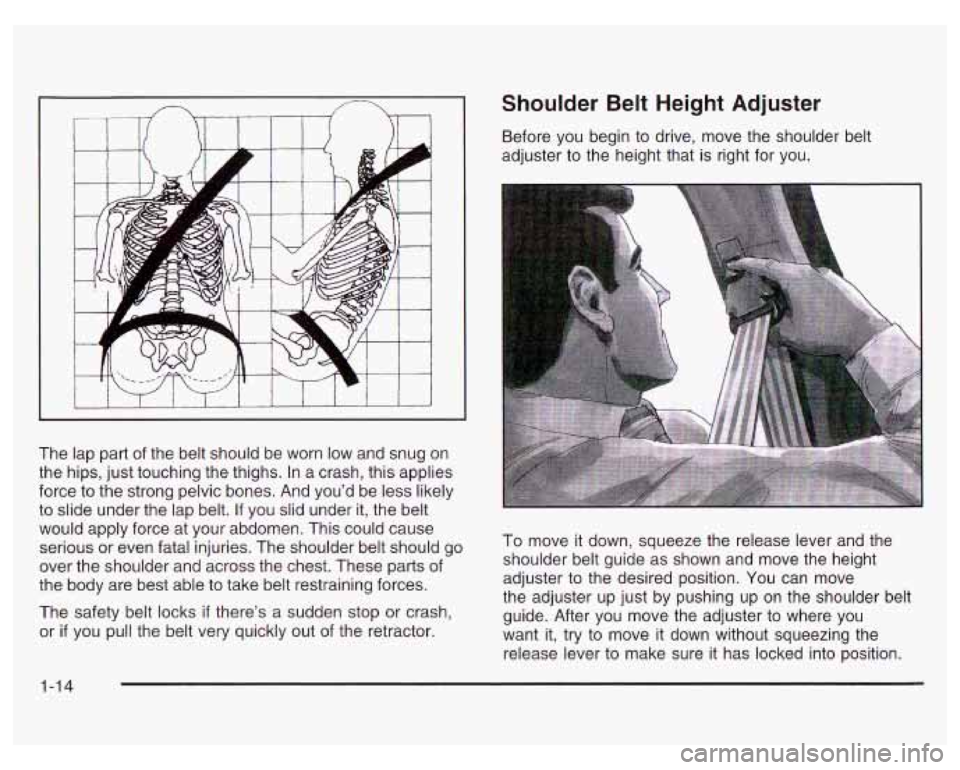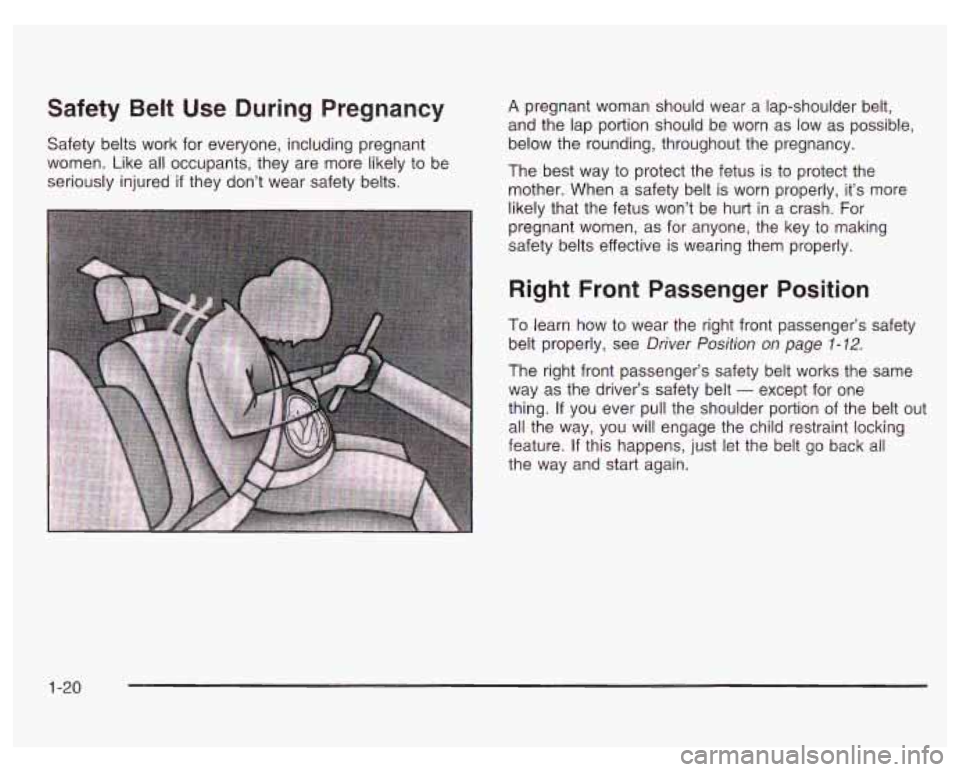Page 20 of 378
Make sure the release button on the buckle is
positioned
so you would be able to unbuckle the
safety belt quickly
if you ever had to.
3. Pick up the latch plate and pull the belt across you.
Don’t let it get twisted.
The shoulder belt may lock
if you pull the belt
across you very quickly.
If this happens, let the belt
go back slightly to unlock it. Then pull the belt
across you more slowly.
4. Push the latch plate into the buckle until it clicks.
Pull up on the latch plate to make sure it is secure.
If
the belt isn’t long enough, see Safety Belt Extender
on page 1-28 at the end of this section.
5. To make the lap part tight, pull down on the buckle
end
of the belt as you pull up on the shoulder belt.
1-13
Page 21 of 378

The lap part of the belt should be worn low and snug on
the hips, just touching the thighs. In a crash, this applies
force to the strong pelvic bones. And you’d be less likely
to slide under the lap belt.
If you slid under it, the belt
would apply force at your abdomen. This could cause
serious or even fatal injuries. The shoulder belt should go
over the shoulder and across the chest. These parts of
the body are best able to take belt restraining forces.
The safety belt locks
if there’s a sudden stop or crash,
or if you pull the belt very quickly out of the retractor.
Shoulder Belt Height Adjuster
Before you begin to drive, move the shoulder belt
adjuster to the height that is right for you.
To move it down, squeeze the release lever and the
shoulder belt guide as shown and move the height
adjuster to the desired position. You can move
the adjuster up just by pushing up on the shoulder belt
guide. After you move the adjuster to where you
want it, try to move it down without squeezing the
release lever to make sure it has locked into position.
1-14
Page 22 of 378
Adjust the height so that the shoulder portion of the belt is
centered on your shoulder. The belt should be away from
your face and neck, but not falling
off your shoulder.
Q: What’s wrong with this? You
can be serLaN,! hurt if your shoulder belt
is too loose. In
a crash, you would move
forward too much, which could increase injury.
The shoulder belt should fit against your body.
I
A: The shoulder belt is too loose. It won’t give nearly
as much protection this way.
1-15
Page 23 of 378
Q: What’s wrong with this?
A: The belt is buckled in the wrong place. You can be seriously injured if your belt is
buckled in the wrong place like this. In a crash,
the belt would go up over your abdomen.
The belt forces would be there, not at the
pelvic bones. This could cause serious internal injuries. Always buckle your belt into the
buckle nearest you.
1-16
Page 24 of 378
Q: What's wrong with this?
A: The shoulder belt is worn under the arm. It should
be worn over the shoulder
at all times.
. JU can be seriously injured if you wear the
shoulder belt under your arm. In a crash, your
body would move
too far forward, which would
increase the chance
of head and neck injury.
Also, the belt would apply too much force to
the ribs, which aren't as strong as shoulder
1 bones. You could also severely injure internal
~ organs like your liver or spleen.
1-17
Page 25 of 378
Q: What’s wrong with this?
I I I I
T You can be seriously injured by a twisted belt.
In a crash, you wouldn’t have the full width of
the belt to spread impact forces.
If a belt is
twisted, make it straight
so it can work
properly, or ask your dealer to fix it.
A: The belt is twisted across the body.
1-18
Page 26 of 378
To unlatch the belt, just push the button on the buckle.
The belt should go back out
of the way.
Before you close the door, be sure the belt
is out of the
way.
If you slam the door on it, you can damage
both the belt and your vehicle.
1-19
Page 27 of 378

Safety Belt Use During Pregnancy
Safety belts work for everyone, including pregnant
women. Like all occupants, they are more likely to be
seriously injured
if they don’t wear safety belts.
A pregnant woman should wear a lap-shoulder belt,
and the lap portion should be worn as low as possible,
below the rounding, throughout the pregnancy.
The best way to protect the fetus is to protect the
mother. When
a safety belt is worn properly, it’s more
likely that the fetus won’t be hurt in a crash. For
pregnant women, as for anyone, the key to making
safety belts effective is wearing them properly.
Right Front Passenger Position
To learn how to wear the right front passenger’s safety
belt properly, see
Driver Position on page 7-12.
The right front passenger’s safety belt works the same
way as the driver’s safety belt
- except for one
thing.
If you ever pull the shoulder portion of the belt out
all the way, you will engage the child restraint locking
feature.
If this happens, just let the belt go back all
the way and start again.
1-20